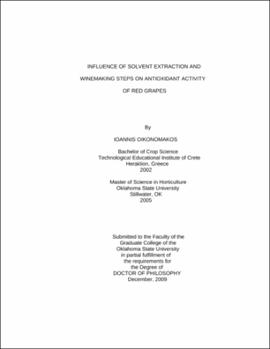| dc.contributor.advisor | McGlynn, William G. | |
| dc.contributor.author | Oikonomakos, Ioannis | |
| dc.date.accessioned | 2013-11-26T08:22:37Z | |
| dc.date.available | 2013-11-26T08:22:37Z | |
| dc.date.issued | 2009-12 | |
| dc.identifier.uri | https://hdl.handle.net/11244/6613 | |
| dc.description.abstract | Scope and Method of Study: Compare different solvent combinations on antioxidant extraction from Cynthiana pomace for potential industrial scale use. Measure the antioxidant activity of Cabernet franc grapes at various steps during wine production. Identify major compounds present in pomace and wine; correlate antioxidant activity with total phenolics present. | |
| dc.description.abstract | Findings and Conclusions: Out of the 32 solvent treatments, 50% Acetone/Water mix proved to be a good extraction medium when used for 2h at 2:1 solvent:sample ratio. Yield of 31micromoles TE/g tissue suggest that Cynthiana pomace is a good source of natural antioxidants, with anthocyanins cyanidin 3-O-glucoside and malvidin 3-O-glucoside being two of the major compounds in the extracts. | |
| dc.description.abstract | Both wine and pomace of Cabernet franc showed high antioxidant activity of approximately 27micromoles TE/mL wine and 56-83micromoles TE/g pomace respectively. Antioxidant activity was also positively correlated with total phenolic content, both for wine and pomace, with average of 762mg Gallic acid equivalents/L of wine and 2mg Gallic acid equivalents/g pomace respectively. The major compounds identified in wine with HPLC were gallic acid and epicatechin, with malvidin 3-O-glucoside in smaller amounts. Pomace extracts contained mainly catechin and epicatechin, with malvidin 3-O-glucoside as the major anthocyanin. Several major peaks were not identified, which suggests that additional compounds might also be responsible for the antioxidant properties of Cabernet franc. | |
| dc.description.abstract | Both experiments suggest that grape pomace from red grape varieties has good antioxidant properties and thus may be a good source of valuable natural compounds. Our method presents a potentially industrial-scale, single-solvent extraction process for screening antioxidants from grape pomace - and possibly other waste streams. Quantification and identification of all major compounds present in the grape pomace is needed to give a better understanding of the true value of the waste streams and also to help determine if further extract processing would be beneficial and/or economically feasible. | |
| dc.format | application/pdf | |
| dc.language | en_US | |
| dc.rights | Copyright is held by the author who has granted the Oklahoma State University Library the non-exclusive right to share this material in its institutional repository. Contact Digital Library Services at lib-dls@okstate.edu or 405-744-9161 for the permission policy on the use, reproduction or distribution of this material. | |
| dc.title | Influence of solvent extraction and winemaking steps on antioxidant activity of red grapes | |
| dc.contributor.committeeMember | DeWitt, Christina | |
| dc.contributor.committeeMember | Maness, Niels O. | |
| dc.contributor.committeeMember | Brandenberger, Lynn Philip | |
| osu.filename | Oikonomakos_okstate_0664D_10678 | |
| osu.accesstype | Open Access | |
| dc.type.genre | Dissertation | |
| dc.type.material | Text | |
| dc.subject.keywords | antioxidant | |
| dc.subject.keywords | extraction | |
| dc.subject.keywords | grape pomace | |
| dc.subject.keywords | ORAC | |
| dc.subject.keywords | polyphenols | |
| dc.subject.keywords | wine | |
| thesis.degree.discipline | Food Science | |
| thesis.degree.grantor | Oklahoma State University | |
